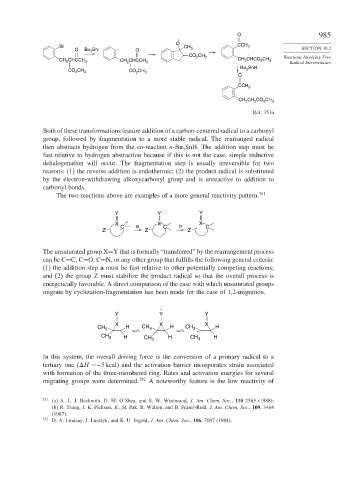Page 1009 - Advanced Organic Chemistry Part B - Reactions & Synthesis
P. 1009
O 985
.
O
Br . CH CCH 3
O Bu 3 Sn . O 3 SECTION 10.3
CO CH . Reactions Involving Free
CHCCH 2 3 CHCO CH
CH 2 3 CH CHCCH 3 CH 2 2 3 Radical Intermediates
2
Bu SnH
CO CH 3 CO CH 3 3
2
2
O
CCH 3
CH CH CO CH 3
2
2
2
Ref. 351a
Both of these transformations feature addition of a carbon-centered radical to a carbonyl
group, followed by fragmentation to a more stable radical. The rearranged radical
then abstracts hydrogen from the co-reactant n-Bu SnH. The addition step must be
3
fast relative to hydrogen abstraction because if this is not the case, simple reductive
dehalogenation will occur. The fragmentation step is usually irreversible for two
reasons: (1) the reverse addition is endothermic; (2) the product radical is substituted
by the electron-withdrawing alkoxycarbonyl group and is unreactive to addition to
carbonyl bonds.
The two reactions above are examples of a more general reactivity pattern. 351
.
Y Y Y
X a X b X
Z . C Z C Z . C
The unsaturated group X=Y that is formally “transferred” by the rearrangement process
can be C=C, C=O, C=N, or any other group that fulfills the following general criteria:
(1) the addition step a must be fast relative to other potentially competing reactions;
and (2) the group Z must stabilize the product radical so that the overall process is
energetically favorable. A direct comparison of the ease with which unsaturated groups
migrate by cyclization-fragmentation has been made for the case of 1,2-migration.
.
Y Y Y
X X X
CH 3 H CH 3 H CH 3 H
. .
CH 3 H CH 3 H CH 3 H
In this system, the overall driving force is the conversion of a primary radical to a
tertiary one (
H ∼−5kcal) and the activation barrier incorporates strain associated
with formation of the three-membered ring. Rates and activation energies for several
migrating groups were determined. 352 A noteworthy feature is the low reactivity of
351 (a) A. L. J. Beckwith, D. M. O’Shea, and S. W. Westwood, J. Am. Chem. Soc., 110 2565 (1988);
(b) R. Tsang, J. K. Pickson, Jr., H. Pak, R. Walton, and B. Fraser-Reid, J. Am. Chem. Soc., 109, 3484
(1987).
352
D. A. Lindsay, J. Lusztyk, and K. U. Ingold, J. Am. Chem. Soc., 106, 7087 (1984).

